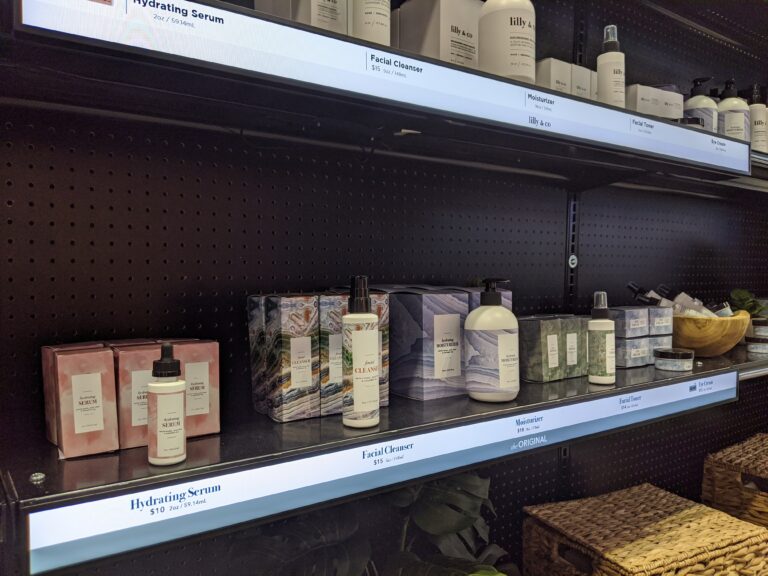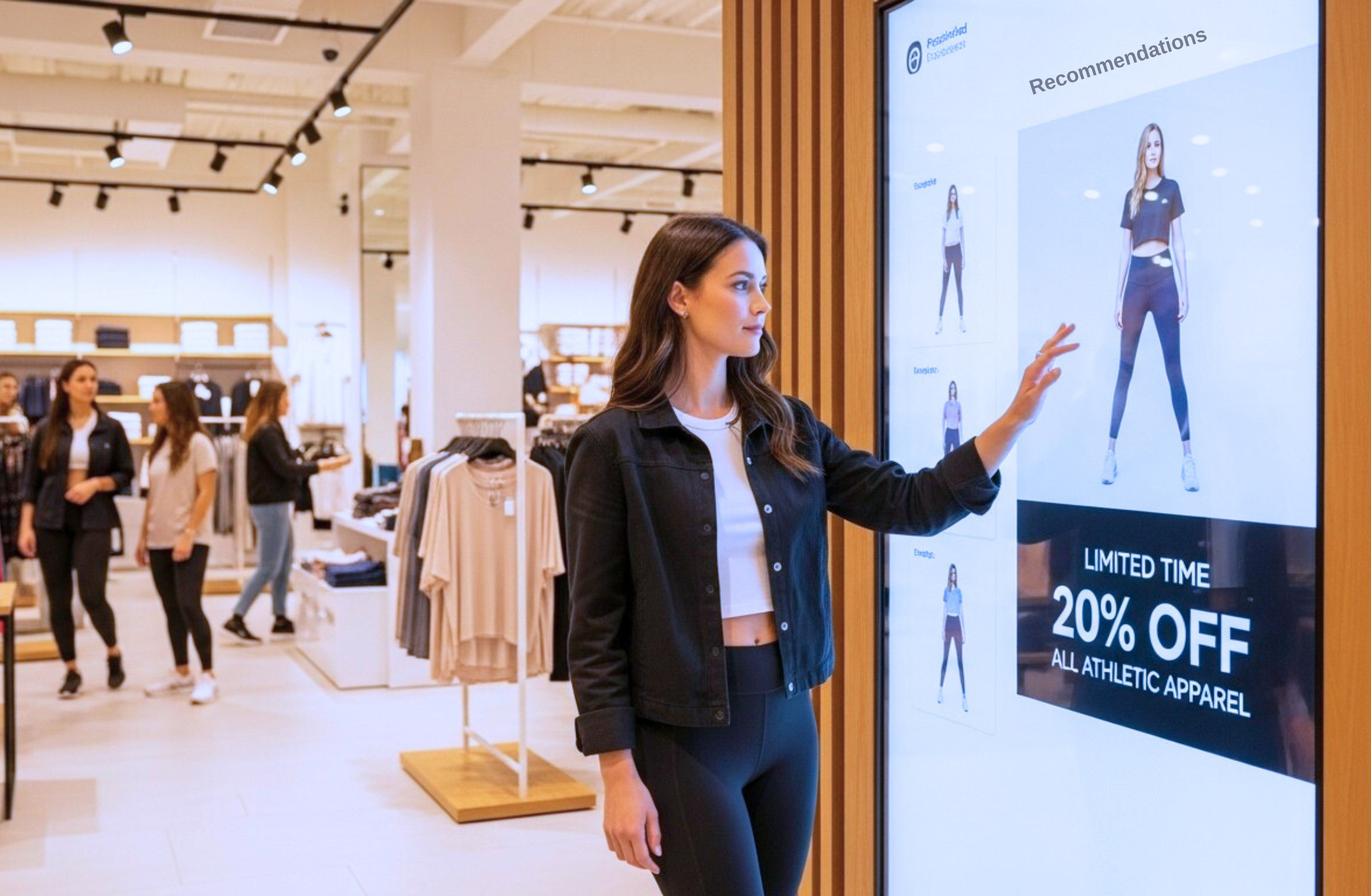
The trends and takeaways from the 2020 National Retail Federation (NRF) show

On a mission to help retailers deliver dynamic content to improve the overall customer experience, the booth at the NRF 2020 Show focused primarily on creating a smart store, demonstrating how retailers can level the playing field with online competition and bring the best of online shopping and efficiency into the store. With advanced digital signage, businesses can use sensor technology to collect data and better understand customer and employee in-store interaction and engagement. This helps retail and marketing teams deliver smarter messaging along the entire shopping journey, by activating location-based marketing to take advantage of that valuable time shoppers spend in the store.
Here, we’ll share the top trends in 2020 on display at NRF and our key takeaways.
If you’re in retail and not in the know about the NRF show, let’s get up to speed. The NRF puts on a massive event each year in New York, NRF 2020: Retail’s Big Show & Expo, for professionals to network, collaborate and showcase what’s exciting in retail across the industry — from floor plans and store fixtures to displays and the latest innovations in retail technology.
With more than 800 exhibits, 100 educational sessions and 40,000 attendees, it’s an opportunity for retailers to see trends that span every aspect of the retail store and e-commerce customer experience, marketing technology and back of the house systems to the latest in visual merchandising. This year’s show had the theme “vision” and focused on two major topics — data and the increasing use of technology, particularly analytics, to drive marketing for retailers.
If you think only giant corporations could benefit from the NRF Show, think again. The Startup Zone gave newcomer emerging technology companies the chance to show off their innovations to industry leaders. This year’s event held more than 100 Exhibitor Big Ideas sessions where industry professionals presented their latest tech solutions, insightful case studies and demos. The show also featured expo tours on AI, customer experience, the future of in-store technologies and digital experience.
Scala and STRATACACHE scoured NRF 2020 for trends, takeaways and innovations worth sharing. Meanwhile, we approached the event with main themes of our own to share. Our marketing technology solutions and personalized on-screen content at the show focused on delivering retail transformation and exceptional customer experiences. We shared innovations around operational efficiency, personalization at scale, frictionless customer experience and in-store insights and data analytics. These themes around delivering an end-to-end customer experience bubbled up in conversations with retailers and at many of the breakout sessions.
Beyond sharing insights on in-store retail innovations such as decision-informed AI and intelligent visual displays in our in-booth theater, we engaged in some market research, attending talks, visiting exhibits and talking to industry experts to put our finger on the pulse of where the industry currently is, where it’s headed and how technology drives transformation.
The main trends that retailers should take note of for 2020, include customizing technology stacks and artificial intelligence. These trends in the retail market industry are poised to help with everything from data collection to customer behavior tracking.
Being able to choose what’s included in your brick and mortar company’s tech stack is a big deal. With the freedom to customize the services that you need, retailers can level the playing field with online shopping by integrating into retailers’ current tech stack to provide further personalization in-store. Customers online are used to instant recommendations and streamlined checkout — mature technology and solutions can bring that level of personalization to your in-store experience today.
One such example is using in-store checkout platforms and mobile apps, retail companies can incorporate elements such as loyalty programs, leveraging information from a loyalty account, to directly improve customer satisfaction and provide one-to-one personalization. By allowing customers to find what they are looking for easily, check out quickly and build points, businesses will find customers are happier and more likely to return.
AI continues to be at the forefront of technology innovations, which was on full display and top of mind at NRF 2020. Today retailers can use these solutions for a range of task-based optimization and messaging including inventory management and sales associate and customer behavior tracking. Simply installing sensors throughout a store allows retailers to track merchandise, employees, high value assets and shoppers to gain key insights and improve the overall business. By keeping track of what’s being sold, patterns, behaviors and where shoppers linger, an in-store analytics platform helps inform targeted messaging, product placement and staff allocation.
For more insights on the 2020 NRF Show trends, check out this podcast by Manolo Almagro, Managing Partner at Q Division.
STRATACACHE team members sat in NRF keynote presentations with industry leaders during the week — here are our key takeaways.
The key to retail growth is customer data. This is why it is vital for retailers to start putting in sensors to collect deep in-store insights about how customers are spending time and money in the store, and how employees are engaging and operating. However, this data is only useful if it’s being utilized in real time.The goal is, after all, to predict the customer’s next move and automate personalized content on any digital display — front of store signage, displays in the back of the house or on mobile. Your back office and front staff must be in sync to maximize efficiency. Appropriately restocking products, organizing product displays and updating space layouts all depend on both groups being aware of what the other is doing.
Another key trend is personalization — how to do it well and how not to do it. Customers don’t want to just be lumped into a consumer group based solely on their basic demographics. Shoppers these days are informed about a brand’s products and services before stepping foot in the store, and they want to feel like they are involved in the brand’s community. Although online shopping has proven to be a great success, a lot of people still want to experience shopping in the store, for reasons such as testing or specifically selecting products, having a memorable experience or having an immediate shopping need. These are aspects of shopping that e-commerce can’t deliver, and where incorporating the benefits of online shopping into the physical world becomes a key factor.
Let’s look at some of the numbers. According to a recent Retail TouchPoints Personalization Benchmark Survey, only about 23% of retailers take advantage of personalized digital display options for customers who opt in to use the company’s mobile app. In other words, brands are spending money to develop an app for customers to use, but they are not utilizing the app to generate customized content for those shoppers. Here are a few more informative statistics:
At this year’s retail event, the STRATACACHE booth displayed retail marketing technology solutions that highlight end-to end shopping experiences, personalization, automation and product discovery. The customer journey — from the store front, aisles, dressing rooms and pick-up queue — needs to offer the convenience and personalization of online shopping while delivering an experience that can only be found in the store. We zoomed in on the major value-add of introducing back-of-house visual displays to track alongside that in-store customer experience.
Our booth had sensors at each retail solution, gathering inputs to demonstrate to retailers the impact of decision-based messaging on visual displays. Put another way, our in-booth dashboards showed sensor inputs that inform an AI engine which ultimately feeds data-optimized messaging to the displays. This smart, data-informed messaging system provides key insights into how a store runs and is transformational both in terms of operations and marketing.
Retailers can get a better understanding of how customers move throughout their space, what products are flying off the shelves and where staff members should be placed to better serve their customers — while AI informs what messages should appear on intelligent visual displays, in real time. This level of customization helps brick-and-mortar retailers compete against online retailers. After all, most people turn to online shopping because they think it’s more convenient than going to the store. However, negative points like expensive shipping costs and not being able to physically touch, select or test the product tend to make many consumers reconsider how they make purchases. To maximize the benefits of online shopping while bringing the best of those digital elements into their physical spaces, retailers need to focus on improving the customer experience inside their stores.
Having a full solution, including software, hardware, services and support, in-house, we demonstrated a range of digital signage options with a focus of learning from the retailer what their consumer engagement goals are.
In addition to our technology and innovations on display at NRF 2020, STRATACACHE made some key announcements.
We announced a strategic technology partnership with Japanese company Hakuhodo DY Holdings — a well known international marketing, advertising and communications company — to jointly develop innovative customer engagement experiences to influence shopper behavior and drive digital transformation. To find out more, click here.
STRATACACHE also announced a strategic partnership with BOE Technology Group, a global leader in the semiconductor display industry and an Internet of Things (IoT) company. Through this partnership, STRATACACHE will broaden its full marketing technology offering, which includes hardware, software and services, with displays delivered under two leading brands in the STRATACACHE family of marketing technology companies. For more on this announcement, click here.
We left NRF 2020 knowing it’s clear that retailers want to compete with ecommerce, and personalizing the shopping experience is key to this fight. Data collection and behavior tracking using sensors and AI are the wave of the future, and the STRATACACHE family is right at the forefront of this movement.
Learn more about Scala’s digital signage solutions today — Contact us to keep up with the latest in smart digital signage.


